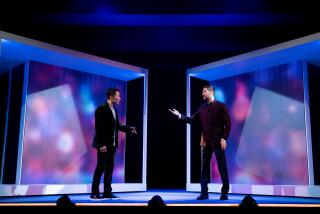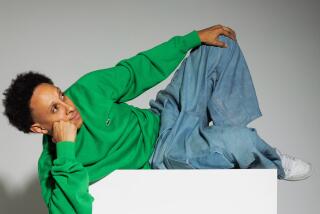Second City’s first-rate legacy
Reporting from Chicago — It was born of University of Chicago nerds at the end of McCarthyism, back when cutting-edge comedy meant jokes about your mother-in-law. It fed on the slow Chicago burn of 1960s counterculture, even though the demons of drugs and alcohol took down more than a few of its brilliant, misfit stars. It gave a tough Midwestern city its own colorfully indigenous, endlessly malleable art form -- satirical sketch-comedy, created through improvisation. After some 35 years in the business, it deftly transformed itself into a shrewdly self-aware farm team for “Saturday Night Live” and the newly expansive world of television comedy, a market that the Second City itself helped create.
Second City, which celebrates a splashy, star-crusted 50th anniversary next weekend, has always danced a delicate pirouette between light and dark, polish and heart, business and art, slickness and spontaneity, maternal nurturing and patriarchal practicality.
The dangers of the drugs and the booze have mostly been replaced by the perils of personal ambition. But it is a dance that gets ever trickier.
“Second City has changed the way the NBA has changed,” says alumnus Tim Kazurinsky. “We used to have blackouts between the scenes -- wine to clear the palate for what comes next. Now it’s more run and gun, fun, fun, fun. You used to get an Alan Arkin and Barbara Harris sketch that would bring a tear to the eye. Now you kill yourself laughing.”
Such dichotomies, and a perennial feeling that the older days were always the purer days, are built into the theater’s DNA. Over the years, Second City has morphed from a collection of colorful Chicago characters to the home of some shrewd entertainment entrepreneurs. When John Belushi finally got his posthumous star on the Hollywood Walk of Fame in 2004, his brother Jim affectionately and aptly referred to him as a “hairy brick.” It is a long way from a hairy brick to Tina Fey.
Indeed, Second City now finds itself a stable, profitable business with $30 million in annual revenue, a licensed offshoot on cruise ships, various multimedia deals and a new raft of midcareer celebrity alumni -- the likes of Steve Carell and Stephen Colbert -- that any Ivy League school would covet. Its 65-year-old owner, Andrew Alexander, says he is in negotiations to buy a lot at Wells and Division streets and build his company a new home with theaters, a training center and headquarters from the ground up.
Yet the very name of the Second City, taken from a snotty 1959 article about Chicago in the New Yorker, embodies the same insecurity that always bedevils its hometown. Over the last 50 years, there have been plenty of offbeat but competitive individuals fighting to run this weird joint in their own image. And for every celebrity alumnus ready to gush about how they had the time of their young lives doing eight mainstage shows a week at what alumnus George Wendt likes to call the “Harvard of comedy,” there are always scores of bitter rejects from its classes and workshops ready with sad stories of how their talents were egregiously overlooked.
“We’re made our share of mistakes,” says Alexander. “But our art has shown it can survive for 50 years. We’ve gone through every political and social change imaginable, and we are still sold out almost every night.”
“We are a business,” says vice president Kelly Leonard. “And yet the talent and the environment here have always been anti-commercial, anti-corporate and challenging of authority. That’s the paradox that sustains this place.”
Paradoxical as it may be, it’s tough to argue that this beloved Chicago institution has lost any of its impact or cultural centrality. On the contrary, it is now more powerful than ever in the media landscape. Even though it has never abandoned a hometown hundreds of miles from the entertainment-industry centers of New York and Los Angeles.
Even though? Maybe because.
Born on Wells Street
“For this Second City thing to work,” says Mick Napier, its marquee director, “it cannot ever be about a manager, an agent, a product or a proposition. It always has to be about a show done in the middle of winter in the Midwest. That keeps everything real.”
The group’s impact on the national comedy business has been well documented in books and articles -- “SCTV,” “Saturday Night Live,” “30 Rock” are just a few of the projects born in large part on Wells Street. The list of alumni, both from Chicago and the Toronto based spinoff, is long and familiar. Mike Myers. Adam McKay. Chris Farley. Nia Vardalos. Shelley Long. Bill Murray. Gilda Radner. John Candy.
But Second City has always insisted that it be viewed and treated as a theater (it has a contract with Actors’ Equity) as distinct from a comedy club. Although many people think that its shows are wholly improvised, they are actually shaped, honed and tightly scripted.
“We use improv as a tool,” says co-founder Bernie Sahlins, “not a performance form. Material rises out of improvisation, but it has been written, tried out and tested before it goes into the show as a finished piece. The improvisation is basically public rehearsals.”
That always-contentious view infuriated many improv gurus, most notably the late Del Close, another quixotic Second City figure. A legendary story has the pair repeating the argument at the hospital, as Close lay on his deathbed, with Sahlins finally conceding that improv could be considered an independent art form. For that day only.
Leonard argues that there are many misconceptions that work in Second City’s favor. “We get people who are prejudiced against going to a theater,” he says. “And if they come in thinking that everything is off the cuff, then they always are going to get blown away.”
Indeed, its influence on the American theater, especially the Chicago theater, is arguably even more profound than its influence on TV comedy. For example, the early plays of David Mamet, who once swept the floors there, were structured almost entirely like staccato Second City sketches.
Second City operates two main theaters, including the mainstage and e.t.c. space, along with touring operations. Tonight it opens its 97th regular mainstage show, “Taming of the Flu,” directed by Napier. For the last several months, the e.t.c cast has performed “Studs Terkel’s Not Working,” in honor of the late activist-author, who surely would have enjoyed the title’s wicked pun on his most famous work of oral history.
Current, much-watched rising stars include Brad Morris, Christina Anthony and Andy St. Clair.
Inventive talent
In 1959, when Sahlins and co-founders Paul Sills and Howard Alk first stuck around 120 cane-backed chairs in a storefront once occupied by a Chinese laundry and offered a cabaret-style collection of topical sketches, Chicago theater was little more than a collection of shells booked by touring shows. That first cast of unknowns, including Eugene Troobnick, Severn Darden and more, changed all that.
“Those names had no Broadway or Hollywood credits attached to them,” says former Chicago Tribune chief critic Richard Christiansen. “Second City was not an import. It was indigenous. It featured young, inventive Chicago talent. It was ours. And most important, it was a success.” With the group establishing Lincoln Park as a creative hub, others theaters, like the Organic and the Body Politic, were soon to follow. For all its aesthetic explorations, the secret to Second City’s longevity can surely be found in its shrewd retention of certain signature ways of doing art and business.
First and foremost, it has always hired (and hired cheap) young, smart, funny, creative performers, kept them around for only two or three years at most, insisted on ownership in perpetuity of the material created while they are working on one of its stages and then taken a benevolent, proprietary interest in their future careers.
By co-opting the language of alumni more typically associated with universities, Second City ensures that audiences see it as a place to see the stars of the future. Conversely, these alumni -- scores of whom are returning for the anniversary weekend -- tend to retain warm memories of the place where they likely got their break and where they got to perform their own material in an ensemble-based setting without the other, more detestable trappings of a hierarchical entertainment business that gets nervous when people are doing their own material.
Second City has always kept ticket prices low (they’re $20-$25) and thus snagged young audiences. You have always been able to get a drink at your seat. It has tried new arenas but resisted dilutions of its brand. It figured out long ago that it didn’t work in New York or Los Angeles (at Santa Monica’s Mayfair Theatre between 1989 and 1991), where it was tough to keep a cast together. It has never allowed its countercultural tendencies to alienate its core audience of suburbanites and tourists, yet it has rarely shied away from blowing up its formulas and risking failure. And it has never forgotten that job one is being smart and being funny.
In the here and the now.
Jones is the theater critic for the Chicago Tribune.
More to Read
The biggest entertainment stories
Get our big stories about Hollywood, film, television, music, arts, culture and more right in your inbox as soon as they publish.
You may occasionally receive promotional content from the Los Angeles Times.










